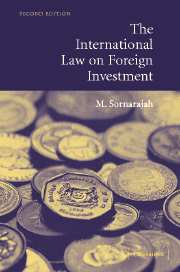Book contents
- Frontmatter
- Contents
- Preface to the second edition
- Preface to the first edition
- Table of cases
- List of abbreviations
- 1 Introduction
- 2 The shaping factors
- 3 Controls by the host state
- 4 The liability of multinational corporations and home state measures
- 5 Bilateral investment treaties
- 6 Multilateral instruments on foreign investment
- 7 Causes of action: breaches of treatment standards
- 8 The taking of foreign property
- 9 Takings in violation of foreign investment agreements
- 10 Compensation for nationalisation of foreign investments
- Bibliography
- Index
9 - Takings in violation of foreign investment agreements
- Frontmatter
- Contents
- Preface to the second edition
- Preface to the first edition
- Table of cases
- List of abbreviations
- 1 Introduction
- 2 The shaping factors
- 3 Controls by the host state
- 4 The liability of multinational corporations and home state measures
- 5 Bilateral investment treaties
- 6 Multilateral instruments on foreign investment
- 7 Causes of action: breaches of treatment standards
- 8 The taking of foreign property
- 9 Takings in violation of foreign investment agreements
- 10 Compensation for nationalisation of foreign investments
- Bibliography
- Index
Summary
The view which formerly prevailed was that a taking in violation of a foreign investment contract was illegal. This view has lost support in recent times. But, the existence of an agreement in which the state makes a commitment not to take the property of the foreign investor for a certain period of time has always had some significance in the law. The view is that such agreements are akin to treaties and their violation is unlawful. There is little support for this view in modern times. But, variations of this theme still continue to exist. The argument is sometimes made that the violation of contractual rights enhances compensation. Because the old view still continues to have echoes in modern law, it is necessary to consider the ramifications of the notion that the foreign investment agreement itself has a status in the law and that its violation brings about certain consequences.
Foreign investment agreements are usually the basis on which entry is made into the host country. They are also the basis on which dispute settlement through arbitration is resorted to when parties are in conflict. The bargaining power of the foreign investor is at its greatest at the moment of entry, and he is best able to secure terms favourable to himself. Prudence requires that these terms be reduced to the form of a contract. The agreement secures the basis on which the expectations of the foreign investor are to be protected. But, the agreement also contains an ‘obsolescing bargain’ in the sense that the bargaining power of the foreign investor diminishes as the foreign investment project progresses.
- Type
- Chapter
- Information
- The International Law on Foreign Investment , pp. 402 - 434Publisher: Cambridge University PressPrint publication year: 2004



